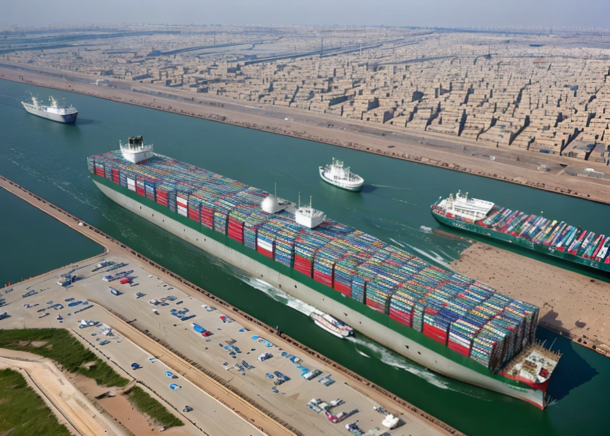Into the Lumpy World
| October 9, 2023
Shortly after I got to Shanghai, I received a phone call. I’d just arrived by high-speed rail from Hangzhou, a journey of 40 or so minutes. It was the reception desk of the hotel I’d left that morning: the cleaning staff had found a jacket in my room, now 170 kilometres away. The man on the other end of the line instructed me to arrange a delivery through WeChat. To my surprise, it cost just 12 RMB (about $1.80) for a courier to bring the lost item to my room by the next morning. I tried to imagine the sheer amount of work, manual and machinic, that it took to correct my oversight. The logistical hubs teeming with thousands of miscellaneous objects, the pathfinding algorithms on cloud computers in distant provinces calculating delivery routes, standardised containers travelling down warehouse chutes, the beep of barcode scanners verifying my digital identity along the way, the guy on the bike who took it on the “last mile” to the reception desk. I have no idea if any of this happened; to me, none of this labour needed to exist.
A meme I recently saw on Instagram joked that these days, you run out of deodorant or something and with a single click start a Rube Goldberg of human suffering twenty miles away. Apparently there are 7 million delivery drivers in China now (and 70,000 of them have master’s degrees). In the U.S. it’s 1.7 million, making up roughly the same proportion—about 0.4%—of the overall population. Coming back to China for the first time in seven years, things did seem ridiculously smooth. It seemed the pandemic had accelerated the number of services which could be accessed with a few swipes. The seamless interaction that launches a flurry of human and mechanical activity from the edgeless glass of an iPhone epitomises the kind of smoothness that has come to characterise urban environments the world over. Cash, which people still carried the last time I was in Shanghai, had all but disappeared, and with it, pockets of loose change. Suddenly, cash seemed like an embarrassingly tangible, nostalgically anonymous form of exchange. An increasingly digitised interface to the city—mediated by QR scanners and WeChat services—announced its intention to evaporate that physicality into weightless surfaces. At the same time, each transaction came with a different kind of baggage, accruing to tangled digital trails associating each insignificant daily activity with the most immutable layers of my legal identity, somewhere in a data centre, far away.

“Drone delivering a package to hotel room”
Courtesy Midjourney
Byung-Chul Han posits that an aesthetics of smoothness—of surfaces without depth, beauty without negativity, presence without absence or excess—characterises the cultural artefacts of globalisation. Somewhat boomerishly, Han identifies this in such contemporary phenomena as the sharing economy, Koons sculptures, cosmetic surgery, selfie culture, self-driving cars (“A self-driving car is no phallus”, he declares). One could easily add to this list: financialisation, same-day delivery, Netflix cinematography, memes. Han’s pining for a more grounded sense of structure, temporality and place resonates today (many of my own friends seem to be turning to religion of some kind), but his ontological nostalgia is largely ambivalent to the historical and technological conditions that engender these aesthetics, and where those conditions may yet lead. The “smooth” is the aesthetic bargain of a de-situated, homogenising world of accelerated information flows and globalising market forces. Its texture of seamless interconnection and endless fungibility reflects the expansionist logics of digital platforms, just-in-time logistics and financial markets. As Fredric Jameson noted decades ago in The Geopolitical Aesthetic (1992), “How could there be private things, let alone privacy, in a situation in which almost everything around us is functionally inserted into larger institutional schemes and frameworks of all kinds, which nonetheless belong to somebody.’
The disenchantment that Han identifies with the dissolution of orderly social life by “the digital” results from a situation in which the mediation of signs and representations across networks—the attentional time they can command—becomes the nominal source of their economic and affective value. It’s an escalation in the informational sphere of what Marx called the “commodity fetish”, in which a world made of social relations between people is mistaken for a world of relations between things, magically detached from the place, people and labour that made them valuable.

“Evergreen stuck in the Suez Canal”
Courtesy Midjourney
Contemporary digital culture, largely defined by social media and driven by e-commerce, is optimised for a user experience that seeks the smoothest path from eyeballs to sales. Perhaps the defining cultural technique of our time, the endless scroll, is the epitome of smoothness, a process by which billions of people simultaneously glide through a personalised universe of digital content in a pseudo-meditative flow-state. It remains both somewhat unsettling and totally mundane that most of us get social life updates, reports of global calamities and recommended products on the same conveyor belt of social media content, all vying for dopamine in the online attention economy. A fly-by piece of content only needs to be fluent in different genres of desire for long enough to convince a user to click through.
The smoothness of “the digital” is symptomatic of the pressure to eradicate transaction costs across the supply chain in a powerfully market-driven information ecosystem. For instance, “dropshipping” companies, the lifestyle products on Instagram you’ve never heard of before, cut out the costs of making goods and holding inventories altogether, focusing instead on building the experience of a minimally viable brand. By taking advantage of targeted social media marketing on one hand and a saturated global supply chain on the other, dropshippers do their business by designing a direct interface between cheap global wholesalers and late night doomscrollers.
On the infrastructural level, as web services raced to eliminate loading times, interfaces over the 2010s grew increasingly minimal, relying on flat colours and emojis over high-definition images. A few years ago, the tech writer Claire Evans coined “Corporate Memphis” to describe the friendly, geometric, pastel-coloured, gender-free and racially-ambiguous graphics that became ubiquitous to tech company branding. These designs are not only cheap to make and low-latency to render, they are designed to scale across contexts, dispatching frictionlessly to marketing teams in San Francisco or Mumbai alike.
But the apparently universal smoothness of the post-digital world has never really been a neutralisation of excess, but rather its relocation elsewhere, typically to cheaper labour markets across the developing world. It takes a lot of work to create a seamless experience, as is evidenced by the very un-smooth labour of social media content moderators who filter the internet’s horrors, Amazon Turkers tasked with cleaning up data sets, and heaving data centres, estimated to use 1-3% of planetary electricity.

“Evergreen stuck in the Suez Canal”
Courtesy Midjourney
Moreover, the homogenising pressure to grow at pace through network effects and monopolise markets was also the product of wider economic conditions. The period of ruthless digital platform expansion following the financial crisis of 2008 was driven by historically low interest rates, allowing venture capital firms like SoftBank and a16z to bet billions of dollars on hundreds of dead horses in search for a “unicorn” success story. In this world of unprecedentedly cheap money, platforms from Meituan to Uber were able to burn through cash for years in an effort to monopolise the market for a given service, before being expected to turn a profit.
The conditions that smoothed the world may not obtain for much longer, at least not in the same form. For one, the pandemic demonstrated the fragility of a global supply chain which had been stretched in pursuit of logistical efficiency over redundancy and resilience. The porous borders presumed by trade liberalisation were suddenly closed, replaced by a nationalist scramble for vaccines and PPE. The ensuing Russian war on Ukraine doubled down on a world reshaped by material crises and natural resource conflicts. Decisively ending the era of globally cheap credit and, perhaps, the era of globalisation as we know it, the past few years have rapidly retired the notion of an increasingly smooth world, gliding towards a horizonless future. History, it turned out, remained lumpy after all, and far from over.
What will become of “smooth aesthetics” as politics and place reassert themselves over the operations of global systems? China’s internet and technology ecosystem, long separated from the rest of the world, already serves as a guide for digital cultures to come. While it’s true that digital life inside China is incredibly seamless, any obstacles to integration (such as a lack of a local bank account or phone number) renders most services inaccessible, turning a smartphone into a relative paperweight. On a wider scale, economic and technological infrastructure lies at the heart of the fracturing global status quo, chiefly centred, like so many things these days, on the geopolitical dynamic playing out between the U.S. and China.
As U.S. economic sanctions on Russia reverberate around the world, the flows of finance, commodities and information are tentatively shifting into new formations. Fears that over-reliance on a U.S.-controlled financial system might land them in the same fate has triggering fresh talks of a departure from the U.S. dollar as the de facto global currency, particularly from the BRICS nations. As the left-wing Brazilian president Lula recently asked an audience at the BRICS development bank in Shanghai, ‘Why should every country be tied to the dollar for trade?’ The coming years will likely witness a deepening balkanisation of digital infrastructure, with battle lines already drawn in recent skirmishes between China and the U.S., from microchip manufacturing to the banning of Huawei and TikTok in various western jurisdictions. While the two superpowers already use different satellite geolocation systems—the U.S. uses GPS while China uses Beidou—the centrality of large-scale technological infrastructures to the future of domestic and global governance will likely result in a bipolar or multipolar patchwork of geopolitical technologies. China, for instance, has already announced its intentions to develop a “New IP” (internet protocol) system for greater regulatory control, while the rapid pace of its 5G infrastructure construction will likely continue as further deals are struck down the Belt and Road.
If smooth aesthetics was underpinned by the accelerated trade dynamics of globalisation, the semiotic soup of digital culture or the expansionist platform capitalism of the 2010s, these factors seem to be evolving into something less homogenous, bearing ever greater friction. Indeed, you could say that smoothness is a low-interest rate phenomenon, in which cheap credit could cover all manner of risks and lubricate any supply chains in need of a fix. (As interest rates have risen, at least in the west, it is the tech sector in particular that has been hit, from the fall of Silicon Valley Bank to hundreds of thousands of layoffs across the industry.) If the smoothness of digitality came to stand for a kind of universality, divorced from specificity, without markings, a “man without character, characterless smoothness”, as Han claims, then this digital existence will soon enter a very different phase.
At the same time, the recent spate of generative AI images have revealed a different kind of smoothness, not so much the disenchanted superficiality critiqued by Han, but an enchantment with the post-digital collective unconscious. Let’s face it, in most cases, the images themselves are boring: at best, a nice trick mirror (“steampunk girl victorian with Sony Lumix bokeh”), a rote fantasy or a viral deepfake. Their smoothness is both textural—often bearing a digital painterly gloss—but also formal, in that each image brings together out the deeply average approximations of the prompts given, tending towards the perfect cliché of each quality (e.g. steampunk-ness) if not given a more specific steer. But as the generative images accumulate, each one almost startlingly generic, they appear to triangulate the beginnings of something more sublime, the cognitive circuits that organise the collective visual imaginary, at least as defined by the archive available on the internet. Such a smoothness, which arises not from a loss of meaning or subjectivity, but an overwhelming of it from a non-human position, might open up some new encounters with beauty.
Gary Zhexi Zhang is an artist and writer whose work explores connections between cosmology, technology and economy. He was born in Suzhou and works in London.


